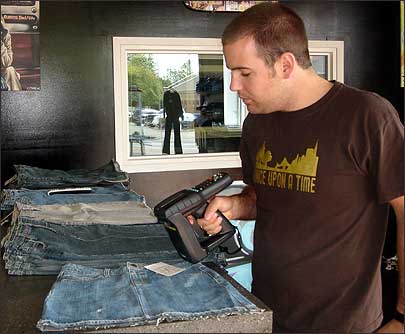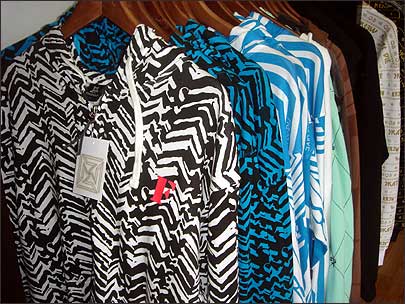The Industry Standard, a month-old boutique in Columbus, Ohio, sells high-end denim, hoodies and other “street couture” worn by the likes of Jay Z and other hip-hop musicians. Place an armful of merchandise—for instance, a T-shirt with a bold, neon green graphic, a huge brown hounds-tooth print hoodie, a pair of even larger jeans, and another hoodie and T-shirt—on the custom concrete countertop, and the system will read the RFID tag attached to each item, create a list of the goods and tabulate the cost, including tax.
This all happens in roughly one second, and without the need of a bar-code scanner. “Customers usually freak when they put product on the counter and I immediately hit one key on the keyboard and tell them their total cost,” says Timothy Kehoe, one of the store’s owners.

All of the store’s merchandise—approximately 1,250 items—carry RFID labels that Kehoe and his business partner, Dominic Petrozzi, have applied to the goods before putting them on the sales floor. They, along with Neco Can—a retail industry veteran with a long history of involvement with RFID and an investor in the store—have big plans for using the technology that go well beyond RFID-enabled check-out terminals. Brad Chuminatto, a longtime business associate of Can’s, architected the RFID systems in the store.
“I’ve been talking about RFID for 11 years. I decided to stop talking and start doing,” says Can, whose résumé lists IT and supply chain positions at Abercrombie & Fitch and the Gap. Can spearheaded RFID trials for both retailers, but says these projects fell short of his long-term vision. He’s very enthusiastic about the approach the Industry Standard is taking to RFID, he says, which he calls a grassroots, creative effort, small enough for him and the store founders to experiment with new applications.
One such experiment taps into a growing movement in retail called social retailing, which uses technology to enable shoppers to confer with friends before making buying decisions. Buried in the wall of the Industry Standard’s dressing room is an RFID interrogator antenna. When a patron enters the room and places items on the wall hook above the concealed antenna, the interrogator reads each item tag’s Electronic Product Codes (EPC), and a Web page showing a photo and description of the item appears on a touch-screen computer monitor mounted on the opposite wall. In some cases, a short biography of the designer may also appear, as well as photos of celebrities wearing the outfit. Some clothing lines are produced by rap artists, so those items tend to carry extra cache among the artists’ fans.
The customer can use the touch-screen to send a text message, along with a link to the page displayed on the screen, to a friend’s cell phone. The customer can then leave the dressing room and stand in front of a common-area mirror, where a video camera will photograph that customer and stream the photos to the store’s Web site. This enables the friend to check out the product details and see how the items look on the customer before giving a thumbs-up or thumbs-down on the purchase.
Can says the store’s customers embrace technology and would rather turn to their friends, via their iPhone or MySpace page, for buying advice, than turn to store employees. “They’ll buy something because they or their friends think it’s cool, or maybe because Jay Z wore it to the Grammys,” he says, “not because we try to sell it to them.”
The store’s unconventional approach to RFID goes right to the hardware level. While just about every other RFID-enabled retailer uses EPC Class 1 Gen 2 passive UHF tags and readers, Industry Standard is using outdated EPC Class 0 tags. The factory-encoded tags, which the store was able to purchase inexpensively, might not perform as well as new tags, but because clothing does not pose RF interference, they perform well enough to meet the store’s present needs.
Eventually, Can says, once the retailer’s current stock of Class 0 tags is depleted, it will begin using EPC Class 1 Gen 2 tags. At that time, the store’s Symbol AR400 fixed-position readers (located under the sales counter and in the dressing room) will receive firmware upgrades to enable them to read and encode to the Gen 2 tags. The store will then need to upgrade the PSC handheld interrogators it currently uses to read the unique number encoded to each Class 0 tag, and scan the Universal Product Code (UPC) of the product to which it is attached, in order to associate the Class 0 tag number with the product in the store’s database.

Industry Standard does not presently have any signage informing customers that it is using RFID to identify merchandise inside the dressing room or at the point of sale. Kehoe says those signs are on the store’s to-do list, but that Industry Standard’s clientele is not concerned that attaching RFID tags to products in the store might put their personal privacy at stake. No customers have objected to the presence of the tags so far, he states, and he doesn’t expect that to change, as they tend to be tech-savvy and accustomed to having their buying habits tracked by retailers.
Moreover, Industry Standard does not remove the tags at the point of purchase because it plans to use them as part of an anti-theft program, in which RFID interrogators installed alongside the store exit will collect the tag IDs of all items a patron carries out of the store. Kehoe says the retailer’s IT director, Ryan Jones, has developed a program that compares the IDs read at the door with the database of purchased items. If any IDs don’t match, employees will see an alert on their point-of-sale system. They can then ask the patron to return to the store to make sure they have purchased everything they’re carrying—or, if the customer runs, they’ll at least know which products were stolen.
Still, Kehoe says he expects to be able to catch some thieves before they even leave the store. Because the read zone of the point-of-sale interrogator extends out toward any customers standing in front of the counter, it should pick up any tags attached to goods a customer has stuffed into his or her jacket or bag. The system will tally up the hidden items, along with the goods placed on the counter, and the store clerk will see that the number of items on the counter does not match the number of goods displayed on the point-of-sale device.
Petrozzi says the retailer is currently working with Can to design a customer loyalty program that will utilize RFID. But rather than employing an open-enrollment model, the store will invite only its most frequent shoppers to join the program. These select customers will receive plastic membership cards carrying UHF tags (initially EPC Class 0, but eventually upgraded to Gen 2). Readers mounted around the store entrance will capture the ID encoded to each card’s tag so that employees can access the member’s name and buying history as soon as that person enters the shop. They’ll then be able to greet the customer, perhaps point out a new product from a designer the customer likes and inform him or her of any special members-only discounts.

